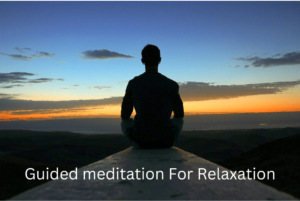Guided Meditation
Actually, when we speak about guided meditation, we target two types of audiences. The first group of people is the beginners for meditation who need some guidance about meditation. The second group of people is the advanced meditation practitioners, like transcendental meditation, who need some guidance for advanced meditation techniques to go deeper into the meditation. Here you will find guided meditation for relaxation and its origin, benefits and the learning methods or places where you can learn guided meditation.
There are various types of meditation in practice among people. Guided meditation is one of them. People practice guided meditation to learn how to focus on thoughts and to bring their attention to a single point.
During guided meditation, the instructor may use meditation music for best relaxation. There is a hidden connection between meditation music and brainwave. If you are an active meditator, you must know brainwaves and brain frequencies. Read both articles for hidden information on brainwaves.
Different Types of Brainwaves – Effects and Function of the Brain
Music can change your brainwaves and frequency which can make connection from conscious mind to super conscious mind. What Brainwaves and Frequency We Need for Meditation?
If you check the internet you can find best guided meditation for sleep or relaxation or even to have good and peaceful sleep in youtube, script and websites. You can also get free guided meditation for five minutes.
Today it is so popular among many because majority of people search for it; not only for relaxation of life but also for spirituality and for finding the meaning of life.
Read meditation and sleep, which have so much of interesting development in itself and as pathway for life relaxation and peaceful sleep.

What is Guided Meditation?
Guided meditation is a form of meditation where an individual is led through the process by a guide or instructor, either in person or through recorded audio or video.
The guide provides instructions and suggestions to help the practitioner relax, focus, and achieve a meditative state.
During practice, one can use visualization techniques, describe calming scenes, or offer affirmations and prompts to focus the mind.
This form of meditation is especially helpful for beginners, because it offers structure and support as they begin it. For beginners, it makes easier to maintain focus and experience the benefits of meditation.
The purpose of it may differ according to the need of the practitioner.
Some guided meditations are designed for relaxation, stress relief, or sleep, while others might focus on specific goals like emotional healing, spiritual growth, or enhancing mindfulness.
Transcendental meditation is for the people who are higher in their spirituality and want to create pure consciousness. Get some ideas on transcendental meditation which is extraordinary in modern fast-paced world.
The Origin of Guided Meditation?
When we research for the origin of the guided meditation, we found that it can be traced back to traditional forms of meditation that have been practiced for thousands of years in various spiritual and religious traditions, particularly in Hinduism and Buddhism. But what we have today is the adoption of ancient meditation practices.
Ancient Roots For Guided Meditation:
There are two types of roots for guided meditation.
- Hinduism and Buddhism: In ancient Hinduism and Buddhism meditation was taught to the followers in the form of guided meditation as a tool for spiritual growth and enlightenment. A guru or teacher would lead disciples through meditation exercises and with powerful techniques such as visualization, mantra repetition, and breath control.
- Yoga and Tantra: Yoga and tantra were taught to the students in the form of guided meditation with complex meditation techniques aimed at awakening spiritual energy and achieving higher states of consciousness.
As we have seen earlier, what we have today is the modern adoption of ancient meditation practices. In that sense we can divide the modern adoptions in three levels of developments.
- Transcendental Meditation (1960s-1970s): It was invented by a teachers Maharishi Mahesh Yogi in India with simple guidance for ordinary people to practice meditation. Later it has spread worldwide and became popular among many because of its new approach in meditation.
- Mindfulness and the Wellness Movement: The next development eventually has taken place in late 20th and early 21st centuries. During this time mindfulness movement has started. Figures like Jon Kabat-Zinn, who developed the Mindfulness-Based Stress Reduction (MBSR) program, used guided meditation as a core component of their teachings. This type of practices were introduced among students to teach how to reduce stress, anxiety, and improve overall well-being
- Modern Adaptations: As latest adaptation in guided meditation, today we do not need a person as guide to instruct during meditation time. Apps, online platforms, and recorded sessions have made it accessible to millions worldwide, allowing people to experience the benefits of it.
Today guided meditation, therefore, blends traditional techniques with modern approaches to suit contemporary needs and lifestyles. With this method people achieve mental clarity, relaxation, and spiritual growth.

What are the Benefits of Guided Meditation?
All want to know the benefits of something before they try it. Guided meditation is not exception for that. People want to know the benefits of guided meditation before they practice it.
Guided meditation offers a range of benefits for both the mind and body.
1. Reduces Stress and Anxiety
- Stress Relief: It helps calm the nervous system, reducing the body’s stress response. Regular practice can help manage anxiety by promoting mindfulness and helping individuals stay grounded in the present moment, reducing the tendency to worry about the future.
2. Improves Focus and Concentration
It helps in focus and concentration with single thought by which one achieve mental clarity and enhanced cognitive function. What is mental clarity and enhanced function? Mental clarity is suitable for today’s fast-paced world.
- Mental Clarity: By guiding the mind to focus on specific images, sounds, or ideas, it can improve concentration and mental clarity. This is particularly beneficial in today’s fast-paced world, where distractions are common.
- Enhanced Cognitive Function: Over time, meditation can improve cognitive function, including memory, attention, and problem-solving skills.
3. Promotes Emotional Well-being
Human beings are based on their emotions. Complex emotions are at function in human ordinary life. Therefore balanced emotions are kept secret for for better well-being. There are two types of emotions in human life. Emotional balance and self compassion. Guided meditation helps in promoting emotional balance for better life.
- Emotional Balance: Guided meditation encourages self-awareness and emotional regulation, helping individuals manage their emotions more effectively. It can also reduce symptoms of depression by fostering a more positive outlook.
- Self-compassion: Some guided meditations focus on self-love and compassion, helping individuals develop a kinder, more forgiving relationship with themselves.
4. Enhances Sleep Quality
Guided meditation is prefered by many beginners and needed people for the reasons that it gives quality sleeps.
By practicing guided meditation one can have peaceful rest and good sleeps which promote good health in mind and body.
- Better Sleep: Guided meditation, especially those designed for sleep, can help individuals fall asleep faster and improve sleep quality. It works by calming the mind and relaxing the body, making it easier to drift into sleep.
- Reduced Insomnia: For those who struggle with insomnia, guided meditation can be a natural remedy to quiet the mind and prepare the body for rest.
5. Supports Physical Health
Following this method, one can experience and develop physical health. There are three main aspects that can works we with this method. Lower blood pressure, pain management and boosted immune system.
- Lower Blood Pressure: Regular meditation can help lower blood pressure by promoting relaxation and reducing stress.
- Pain Management: Guided meditation can be used as a tool for pain management. By focusing the mind away from the pain and promoting relaxation, it can reduce the perception of pain.
- Boosted Immune System: Stress reduction through meditation can strengthen the immune system, making the body more resilient to illness.
6. Fosters Spiritual Growth
People want to practice guided meditation for happiness, inner peace and spiritual growth.
Practicing it you will begin to feel inner peace which may change the way we loot at the world.
- Inner Peace: Guided meditation often leads to a deep sense of inner peace and contentment. It helps individuals connect with their inner selves and develop a sense of purpose and meaning.
- Spiritual Awareness: For those on a spiritual journey, guided meditation can be a way to explore deeper levels of consciousness, connect with a higher power, or achieve a sense of unity with the universe.
7. Encourages Mindfulness
- Present-Moment Awareness: Guided meditation promotes mindfulness, the practice of being fully present in the moment. This can lead to greater appreciation for life’s simple pleasures and a reduction in negative thought patterns.
- Improved Relationships: By enhancing self-awareness and emotional regulation, mindfulness can improve interpersonal relationships, making individuals more empathetic, patient, and understanding.
8. Accessible to All
- Ease of Practice: This method is accessible to beginners and experienced meditators alike. With the guidance provided, individuals can easily enter a meditative state without needing extensive experience or knowledge.
- Customizable: There are many types of meditations available, catering to different needs and preferences, from relaxation and stress relief to spiritual growth and personal development.
Overall, guided meditation is a powerful tool for enhancing mental, emotional, and physical well-being, offering a practical and accessible way to achieve a more balanced and fulfilling life.
Where Can I Learn Guided Meditation?
After completing reading this article, you may have the feeling of learning the methods now. Because it is so rich that you can benefits lots of healthy and spiritual blessings.
The next thought that will emerge in your mind is how can I learn it? or where can I learn guided meditation?
You can find some resources down here for learning it.
Here are some popular options for guided meditation:
1. Mobile Apps
- Headspace: Offers a wide variety of guided meditations for different needs, including stress, sleep, focus, and more. It’s beginner-friendly and includes courses to help you learn meditation step by step.
- Calm: Known for its soothing voice guides and a vast library of meditations for sleep, relaxation, and mindfulness. It also features sleep stories and music.
- Insight Timer: Provides a large collection of meditations from different teachers and traditions, along with features like timers and community groups.
- MyLife (formerly Stop, Breathe & Think): Personalized recommendations based on your current mood and needs, with meditations tailored to help you manage emotions and stress.
2. Online Platforms and Websites
- YouTube: There are countless guided meditation videos on YouTube, ranging from short sessions to longer, more in-depth practices. Popular channels include The Honest Guys, Great Meditation, and Jason Stephenson – Sleep Meditation Music.
- Meditation Oasis: Offers free guided meditations on its website and podcast, covering topics like relaxation, mindfulness, and sleep.
- Tara Brach: A well-known meditation teacher who offers free guided meditations on her website. Her teachings blend mindfulness with compassion, and she also has a podcast with talks and guided practices.
3. Books with Audio Guides
- “The Miracle of Mindfulness” by Thich Nhat Hanh: This book comes with simple instructions and includes access to audio resources that guide you through various meditations.
- “Wherever You Go, There You Are” by Jon Kabat-Zinn: A classic book on mindfulness that includes practical guidance for incorporating meditation into your daily life.
- “Mindfulness in Plain English” by Bhante Henepola Gunaratana: An accessible guide to mindfulness meditation, often used by beginners. Some editions include access to guided audio sessions.
4. Local Meditation Classes and Workshops
- Yoga Studios: Many yoga studios offer guided meditation classes as part of their schedule. Check with local studios to see what’s available in your area.
- Community Centers: Some community centers and wellness clinics offer meditation classes, often at affordable rates or even for free.
- Retreat Centers: If you’re interested in a more immersive experience, meditation retreats provide in-depth guided meditation sessions, often over several days.
5. Online Courses
- Udemy and Coursera: These platforms offer various courses on guided meditation and mindfulness, with both free and paid options. The courses are often self-paced, allowing you to learn at your convenience.
- Mindful Schools: Offers online courses specifically designed to teach mindfulness and meditation, particularly for educators, parents, and children.
- Sounds True: An online platform that offers courses and audio programs on guided meditation from well-known teachers like Eckhart Tolle, Pema Chödrön, and Jack Kornfield.
6. Podcasts
- The Daily Meditation Podcast: Offers short, practice each day, covering various themes and meditation techniques.
- Sleepy Time Mumbles: Focuses on guided meditations that help listeners fall asleep.
- Untangle: Interviews experts in mindfulness and meditation, along with guided sessions.
7. Personal Instructors
- Meditation Coaches: You can hire a coach or instructor who provides personalized teaching sessions, either in person or online. This can be particularly beneficial if you want tailored guidance.
- Spiritual Centers: Some spiritual or religious centers offer sessions as part of their services. This can be a good option if you’re looking for a community-oriented experience.
These resources provide a variety of ways to learn and practice it, whether you prefer digital options, in-person classes, or self-study through books and courses.
Conclusion:
Guided meditation is a form of meditation with a instructor or teacher. By following it you will get many benefits. You can learn it in online or with direct instruction of a teacher. In today’s world there are so much of good opportunities that you can learn this method.





